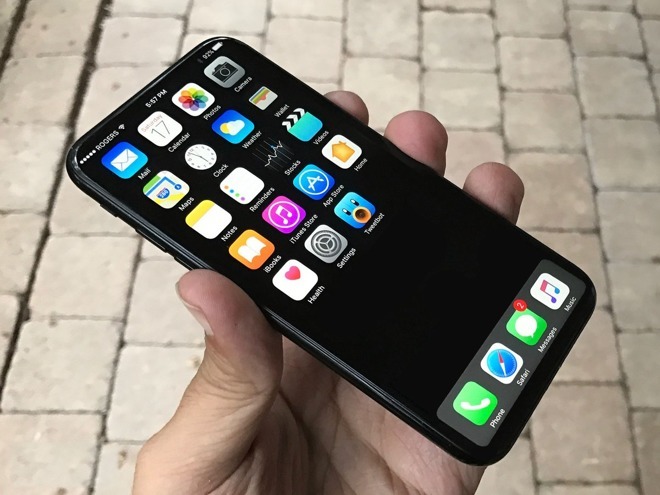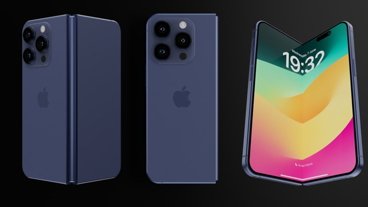While this year's iPhone lineup is expected to feature just one model with an OLED display — the flagship "iPhone 8" — the company is rumored to embrace the display technology in a big way a year later, when it could offer three OLED iPhones.
Apple apparently has three different OLED iPhone models in the works for the second half of 2018, according to Nikkei. The report cautioned that plans are subject to change, particularly with potential supply constraints.
To date, Apple has not utilized OLED technology in its iPhone. Its only OLED products are the Apple Watch and the MacBook Pro Touch Bar.
That's expected to change this fall, with the so-called "iPhone 8" rumored to feature a 5.2-inch OLED display. It's believed that the handset will be a premium-priced, flagship model, flanked by "iPhone 7s" models sporting traditional LCD screens in 4.7- and 5.5-inch form factors.
Thursday's report didn't give any indication as to what screen sizes could use OLED panels in the second half of 2018. It's possible that Apple could stick with sizes of 4.7, 5.2 and 5.5 inches, or do something else entirely — like an even larger "phablet" device, or a next-generation 4-inch successor to the iPhone SE.
According to Nikkei, the LCD "iPhone 7s" and "iPhone 7s Plus" are expected to be sold into early 2019, likely transitioning into budget models after a fall of 2018 refresh, if Apple sticks to its usual release schedules.
With OLED technology, each individual pixel is self-lit, which means "black" (unused) pixels do not require as much power as illuminated pixels. OLED panels can also be flexible, allowing for new form factors like curved screens.
 "iPhone 8" OLED concept via iMore.
"iPhone 8" OLED concept via iMore.The OLED screen in the Apple Watch is paired with a dark user interface, playing a key role in giving the wearable device a full day of battery life. A long-rumored "dark mode" in iOS could offer similar battery savings for OLED-equipped iPhones.
For now, this year's "iPhone 8" is expected to be produced in extremely limited quantities, held back by a number of new technologies rumored to be introduced, including an edge-to-edge OLED screen that will see the removal of bezels and the physical home button. As plans for the 2018 iPhone lineup begin to shape up, it sounds as though Apple hopes that any OLED capacity issues will be resolved over the next year.
To that end, Apple has been investing significantly in OLED manufacturers and facilities, aiming to boost production of displays beyond what the market can currently provide. The world's top OLED manufacturer, Samsung, has also been spending billions to increase capacity in anticipation of Apple's switch to OLED.
 Neil Hughes
Neil Hughes







-m.jpg)






 Bon Adamson
Bon Adamson
 Marko Zivkovic
Marko Zivkovic
 Amber Neely
Amber Neely
 Malcolm Owen
Malcolm Owen


 Christine McKee
Christine McKee



-m.jpg)






8 Comments
Apple can eliminate the ability for the Chinese manufacturers to compete in the mobile market by taking all of Samsung's OLED production capability. No other company is capable of producing high quality display panels in the capacity that Samsung can.
The next version of the Pixel will likely revert back back to LCD. It will be interesting to see the Google apologists explain that one away.
And it isn't just the display panels. NAND memory is constrained. Sony is positioning itself as a supplier primarily to Apple for digital imaging sensors.
Android is going to be squeezed heavily by the general lack of hardware capability outside of Samsung and Apple.
Samsung is well on its way in its long term goal of displacing Android with Tizen. It is happening in wearables and will soon be coming to the smartphone arena.
Samsung and Apple by working together can eliminate the viability of android as a mobile platform.
I suspect that Cook doesn't see things that way given his desires to develop LG into a legimate competitor. There's essentially no way that it can happen now. Samsung has far too much of a lead. LG also doesn't manufacture cutting edge flash memory products. Apple has to work with Samsung anyhow.
What seems to be happening is that the Chinese manufacturers will be paying far more for access to the hardware technologies, selling their handsets at a loss to compete with the likes of Samsung and Apple.
Samsung and Apple are about to put additional and considerable distance in the hardware capabilities of their own products and the rest of the device manufacturers. Since Google has already cast the dice in favor of the Chinese, they are now forced to watch the likes of Oppo, Huawei and Xiaomi flounder in attempting to compete. If Samsung moves the US and Europe over to its Tizen products, Android is essentially relegated to the Chinese market where the Google play store and Google services are non-existent.
Such a great decision by Google to alienate their most capable hardware manufacturer. I doubt that there is anything that Goolge can do these days to change Samsung's intent with Tizen.
Porting software over to Tizen will be far easier than developing hardware capabilities to compete with the likes of Samsung. In fact, there seems to be a lot of activity in bringing software apps to the Tizen based Watch these days.
Such arrogance on Google's part to think that Samsung's hardware capabilities were trumped by Google in software. It's going to bite Google. It won't be something that will heal either as Samsung is aiming right for the jugular.
Google hasn't sold all that Many Pixels, a Million or so?!?! Not a whole lot, so it's a tiny dent that wouldn't matter much if they stuck to OLED. Samesung should have moved to TIzen a few years ago. I don't know if it's to late at this point to do it? I can't see Apple going a 4th year with the same design as the iPhone 6 I have now with the new phones coming out. They milked it for 3 years now. I'm waiting for real news on the new phones before I make up my mind, Upgrade or go for 4 years with this phone!!!